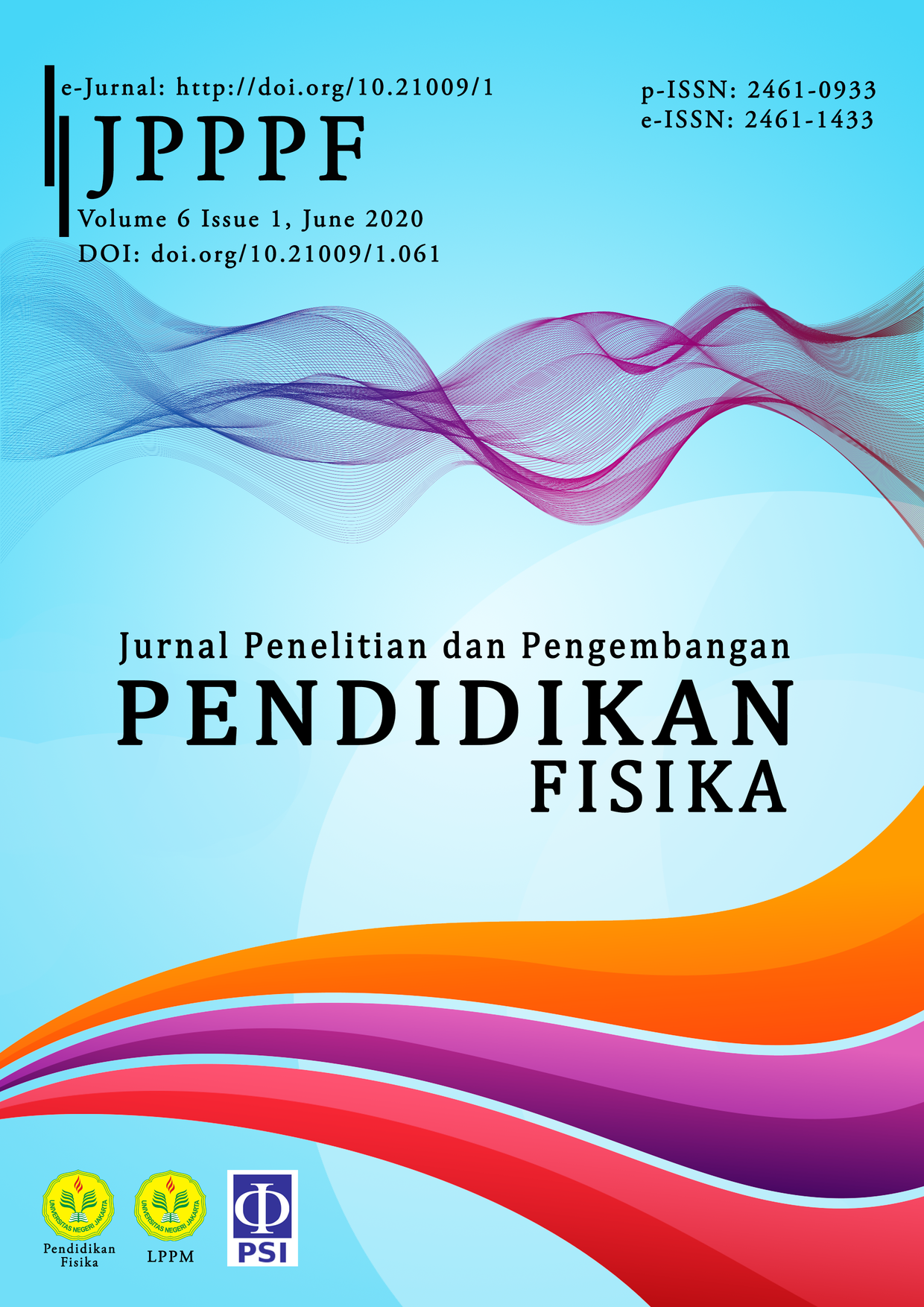Designing MOOCs with VMS (Virtual Microscopic Simulation) for Measurement Student’s Level Understanding (LU)
DOI:
https://doi.org/10.21009/1.06103Keywords:
MOOCs, Virtual Microscopic Simulation (VMS), electric conceptAbstract
The aims of this research to design Massive Online Open Courses (MOOCs) from now on referred to as Virtual Microscopic Simulation (VMS) to measure the Level Understanding (LU) of the construction of microscopic phenomena electric-field conceptions. The research method used is a mixed-method using embedded design. The research subjects are high school students, and one of the universities in Banten Province. The results of this study are software with features in the form of MOOCs-VMS that are categorized very well based on expert judgment on aspects of usability and learning content. The average score of media expert validation score is 96% with a very feasible category, the average score for material expert validation is 98% with a very decent category, and the average user response rate is 86% with a very good category. It can be concluded that the design of MOOCs-VMS can be used as an alternative media for conducting distance learning and is significant in building the level of understanding students.
References
Creswell, JW & Creswell, JD 2018, Research design: Qualitative, quantitative, and mixed methods approaches, Sage publications, California.
Darmawan, I.A, Wiyono, G, & Khairudin, M 2018, ‘Development skills for growing the society’s economy through technical and vocational education and training centers’, Journal of Mechanical Engineering and Vocational Education (JoMEVE), vol. 1, no. 1, pp. 37-48.
Dega, BG, Kriek, J, & Mogese, TF 2013, ‘Students’ conceptual change in electricity and magnetism using simulations: A comparison of cognitive perturbation and cognitive conflict’, Journal of Research in Science Teaching, vol. 50, no. 6, pp. 677-699.
Djanette, B, Fouad, C, & Djamel, K 2013, ‘What thinks’ the university’s students about propagarion of light in the vacuum?’, European Scientific Journal, vol. 9, no. 24, pp. 197-213.
Garrido, CC, Olazabalaga, IM, & Ruiz, UG 2015, ‘Design, motivation and performance in a cooperative MOOC course’, Comunicar: Media Education Research Journal, vol. 23, no. 1.
Gould, H & Tobochnik, J 2010, Statistical and thermal physics: with computer applications, Princeton University Press.
Guntara, Y & Wilujueng, I 2018, ‘Pengembangan perangkat inductive thinking untuk peneingkatan kemampuan representasi data dan penalaran ilmiah’, Jurnal Kependidikan, vol. 2, no. 2, pp. 302-319.
Kaewkhong, K, Mazzolini, A, Emarat, N, & Arayathanitkul, K 2010, ‘Thai high-school students’ misconceptions about and models of light refraction through a planar surface’, Physics Education, vol. 45, no. 1, pp. 91-101.
Kusminarto, K 2014, ‘Implikasi KKNI pada Kurikulum dan Pembelajaran Sains’, Prosiding: Seminar Nasional Fisika dan Pendidikan Fisika, vol. 5, no. 1
Littlejohn, A, Hood, N, Milligan, C, & Mustain, P 2016, ‘Learning in MOOCs: Motivations and self-regulated learning in MOOCs’, The Internet and Higher Education, vol. 29, no. 1, pp. 40-48.
Macabebe, EQB, Culaba, IB, & Maquiling, JT 2010, ‘Pre‐conceptions of Newton’s Laws of motion of students in introductory physics’, AIP Conference Proceedings, vol. 1263, no. 1, pp. 106-109.
McLoughlin, C & Lee, MJ 2010, ‘Personalised and self regulated learning in the Web 2.0 era: International exemplars of innovative pedagogy using social software’, Australasian Journal of Educational Technology, vol 26, no. 1, pp. 28-43.
Merchant, Z, Goetz, ET, Cifuentes, L, Keeney-Kennicutt, W, & Davis, TJ 2014, ‘Effectiveness of virtual reality-based instruction on students’ learning outcomes in K-12 and higher education: A meta-analysis’, Computers & Education, vol. 70, pp. 29-40.
Mikropoulos, TA & Natsis, A 2011, ‘Educational virtual environments: A ten-year review of empirical research (1999–2009)’, Computers & Education, vol 56, no 3, pp. 769-780.
Nurhayati, N & Rohman, I 2015, ‘Rancang Bangun Virtual Laboratory Pemuaian untuk SMP’, Jurnal Penelitian & Pengembangan Pendidikan Fisika, vol 1, no 1, pp. 55-60.
Permatasari, GA, Ellianawati, E, & Hardyanto, W 2019, ‘Online Web-Based Learning and Assessment Tool in Vocational High School for Physics’, Jurnal Penelitian & Pengembangan Pendidikan Fisika, vol. 5, no. 1, pp. 1-8.
Potkonjak, V, Gardner, M, Callaghan, V, Mattila, P, Guetl, C, Petrović, V M, & Jovanović, K 2016, ‘Virtual laboratories for education in science, technology, and engineering: A review’, Comp. & Educ.vol. 95, no. 1, pp. 309-327.
Saglam-Arslan, A & Devecioglu, Y 2010, ‘Student teachers’ levels of understanding and model of understanding about Newton’s laws of motion’, Asia-pacific Forum on science learning & Teaching vol. 11, no. 1.
Shea, P & Bidjerano, T 2010, ‘Learning presence: Towards a theory of self-efficacy, self-regulation, and the development of a communities of inquiry in online and blended learning environments’, Comp. & Educ., vol. 55, no. 4, pp. 1721-1731.
Sinulingga, P, Hartanto, TJ, & Santoso, B 2016, ‘Implementasi pembelajaran fisika berbantuan media simulasi phet untuk meningkatkan hasil belajar siswa pada materi listrik dinamis’, Jurnal Penelitian & Pengembangan Pendidikan Fisika, vol 2, no. 1, pp. 57-64.
Wibowo, FC, Suhandi, A, Rusdiana, D, Ruhiat, Y, Darman, DR, & Samsudin, A 2017, ‘Effectiveness of microscopic virtual simulation (MVS) for conceptualizing students’ conceptions on phase transitions’, Advanced Science Letters, vol. 23, no. 2, pp.839-843.
Widianingtiyas, L, Siswoyo, & Bakri, F 2015, ‘Pengaruh pendekatan multi representasi dalam pembelajaran fisika terhadap kemampuan kognitif siswa SMA’, Jurnal Penelitian &Pengembangan Pendidikan Fisika, vol. 1, no. 1, pp.31-38.











